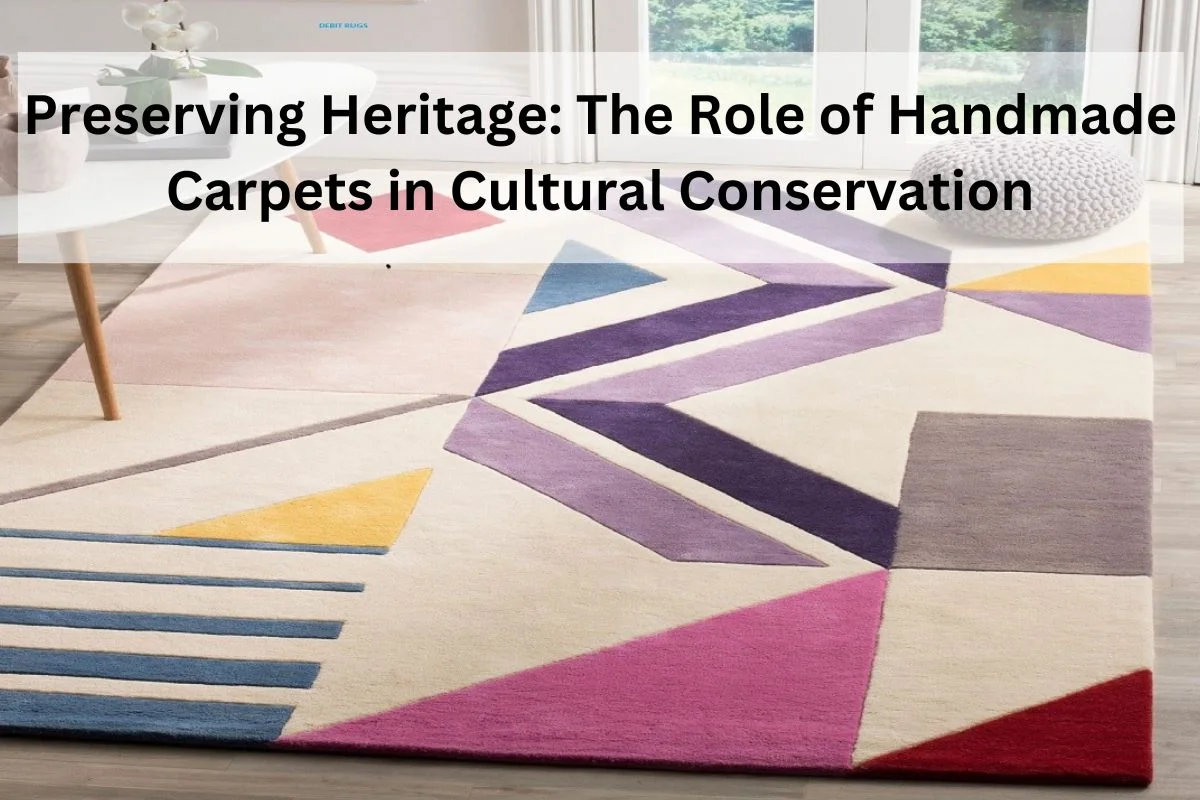Handmade carpets embody a timeless artistry that transcends mere floor coverings, weaving together tradition, skill, and cultural narratives into every intricate knot. Crafted with meticulous care, these carpets are a testament to the enduring legacy of artisanal craftsmanship. Each thread tells a story, reflecting the cultural identity and heritage of the communities that breathe life into these textile masterpieces. The creation of a handmade carpet is a labour-intensive process, involving the expertise of skilled artisans who pass down their knowledge through generations. From selecting the finest materials to the rhythmic dance of hands tying each knot, the craftsmanship involved is both a celebration of heritage and a commitment to preserving time-honoured techniques.
Importance of cultural conservation of hand made carpet
Cultural Identity and Heritage:
Handmade carpets are often deeply rooted in the cultural identity of a particular region or community. The unique designs, patterns, and techniques used in crafting these carpets are a visual representation of the cultural heritage passed down through generations. Conserving this art form helps maintain a connection to the roots and history of a community.
Symbolism and Storytelling:
Handmade carpets are not merely decorative pieces; they often carry symbolic meanings and tell stories. The motifs and patterns can represent aspects of folklore, mythology, or daily life specific to a particular culture. Preserving these carpets ensures that the narratives encoded within them continue to be shared and understood.
Craftsmanship and Traditional Skills:
The art of making handmade carpets involves intricate craftsmanship and specialised skills that have been honed over centuries. By conserving this traditional knowledge, we not only celebrate the mastery of artisans but also ensure the transmission of skills to future generations. This preservation is crucial in maintaining the authenticity and uniqueness of handmade carpets.
Economic Sustainability for Artisans:
Many communities depend on carpet-making as a source of livelihood. The decline of traditional handmade carpet production can have adverse effects on the economic well-being of artisans and their communities. Supporting and conserving this cultural heritage is, therefore, a means of promoting sustainable livelihoods and preserving the social fabric of these communities
Environmental Sustainability:
Handmade carpets are often crafted using natural materials and traditional methods that are more environmentally friendly than mass-produced, machine-made alternatives. By encouraging the continued production of handmade carpets, we contribute to sustainable practices and minimise the environmental impact associated with industrial manufacturing.
Resistance to Homogenization:
In an era of globalisation and mass production, the cultural diversity reflected in handmade carpets stands as a testament to the rich tapestry of human expression. Conserving these traditions helps resist the homogenization of cultures, ensuring that distinct artistic voices and regional nuances persist in the face of cultural assimilation.
Tourism and Cultural Exchange:
Handmade carpets are often considered valuable cultural artefacts. The conservation of this craft enhances cultural tourism, attracting individuals interested in experiencing and learning about the unique heritage associated with these carpets. This, in turn, fosters cultural exchange and understanding between different communities and nations.
Types of handmade carpets
Handmade carpets come in a diverse range of styles, each reflecting the unique traditions, techniques, and cultural influences of the regions where they are crafted. Here are some notable types of handmade carpets:
Persian Carpets:
Persian carpets, also known as Iranian carpets, are perhaps the most renowned and sought-after handmade carpets globally. They often feature intricate designs, vibrant colours, and detailed patterns that vary by region, such as Isfahan, Tabriz, and Kashan.
Oriental Carpets:
Oriental carpets encompass a broad category that includes handmade carpets from various Asian countries, such as Turkey, India, China, and Afghanistan. Each region contributes distinct designs, motifs, and weaving techniques to create carpets with unique cultural flavours.
Turkish Carpets:
Turkish carpets, including those from regions like Anatolia, are celebrated for their bold geometric patterns and rich colours. Kilim rugs, a type of flat-woven Turkish carpet, are especially popular and known for their versatility.
Moroccan Rugs:
Handmade Moroccan rugs, particularly those crafted by the Berber tribes, are characterised by their simplicity, tribal motifs, and shaggy pile.
Advantages of Handmade Carpets
Natural fibres used in hand Handmade carpets offer numerous advantages that contribute to their enduring popularity and appeal. Here are several key advantages of choosing handcrafted carpets:
Artisan Craftsmanship:
Handmade carpets are meticulously crafted by skilled artisans, showcasing a level of artistry and attention to detail that is unparalleled. Each piece is a unique expression of the artisan’s skill, making it a true work of art.
Individuality and Uniqueness:
Unlike mass-produced carpets, each handmade piece is unique. The variations in patterns, colours, and textures add a distinctive charm to every carpet, allowing you to own a one-of-a-kind creation.
Cultural Heritage and Tradition:
Handmade carpets often carry the cultural heritage and traditions of the communities where they are crafted. Choosing these carpets allows you to bring a piece of cultural richness and history into your home.
Quality Materials:
Artisans often use high-quality, natural materials such as wool or silk in crafting handmade carpets. This not only enhances the aesthetic appeal but also contributes to the carpet’s durability and longevity.
Customization Options:
Many artisans offer customization options, allowing you to choose specific colours, patterns, and sizes that suit your preferences and complement your interior décor. This level of personalization ensures that your carpet aligns perfectly with your vision.
Environmental Sustainability:
Handmade carpets are often crafted using sustainable practices, including natural dyes and eco-friendly materials. By choosing handmade, you contribute to environmentally conscious choices in home décor.
Durability and Longevity:
The craftsmanship and quality materials used in handmade carpets result in a product that is more durable and long-lasting compared to machine-made alternatives. With proper care, these carpets can withstand the test of time.
Investment Value:
Handmade carpets are often considered valuable investments. Certain styles or those crafted by renowned artisans may appreciate in value over time, making them not only a beautiful addition to your home but also a potential asset.
Softness and Comfort:
made carpets, such as wool, provide a soft and luxurious feel underfoot. This adds a level of comfort to your living spaces, making them more inviting and cosy.
Timeless Aesthetics:
Handmade carpets feature classic and timeless designs that do not go out of style. This ensures that your investment in a handmade carpet will continue to enhance your home’s aesthetic appeal for years to come.
Disadvantage of Hand made Carpet
While handmade carpets possess numerous advantages, it’s important to consider potential disadvantages associated with their production and use. Here are some factors to keep in mind:
Cost:
Handmade carpets are often more expensive than machine-made counterparts due to the labour-intensive nature of their production. The intricate craftsmanship and time invested by skilled artisans contribute to a higher price point.
Time-Consuming Production:
Crafting a handmade carpet is a time-consuming process. The meticulous weaving of each knot can take weeks or even months, leading to longer production times compared to machine-made alternatives.
Limited Availability:
Handmade carpets are produced in smaller quantities, limiting the availability of specific designs or sizes. This can pose a challenge if you are looking for a particular style that may not be readily accessible.
Variations in Quality:
The quality of handmade carpets can vary depending on the skill and experience of the artisan, as well as the materials used. Some handmade carpets may be more susceptible to wear and tear if not crafted with the utmost care and expertise.
Maintenance Requirements:
Handmade carpets may require more delicate care compared to machine-made options. Specialised cleaning methods and precautions may be necessary to preserve the integrity of the natural fibres and dyes used in their production.
Susceptibility to Environmental Factors:
Natural fibres used in handmade carpets, such as wool, may be more prone to damage from environmental factors like moisture and pests. Proper care and maintenance are crucial to prevent issues such as mould or insect damage.
Limited Design Replication:
Achieving precise design replication in handmade carpets can be challenging. If you desire an exact match for a particular design, a handmade carpet may not offer the level of uniformity seen in machine-made options.
Not Ideal for High-Traffic Areas:
Handmade carpets may not be the best choice for areas with heavy foot traffic. Their intricate designs and delicate materials could be more prone to wear and damage in such environments.
Dependency on Artisan Skills:
The quality and aesthetic appeal of handmade carpets heavily depend on the skills and expertise of the artisan. Variations in craftsmanship can result in differences in the final product.
Economic Impact on Artisans:
While supporting artisans is a positive aspect, the economic sustainability of handmade carpet production can be a challenge. Some artisans may face financial difficulties due to the time-intensive nature of their work and the competition with mass-produced alternatives.
Frequently Asked Questions about Handmade Carpet
How do you clean hand made carpet ?
Cleaning a handmade carpet requires careful attention to preserve its beauty and longevity. Here’s a general guide on how to clean a handmade carpet:
Regular Vacuuming:
Use a vacuum cleaner with a low-suction setting and a soft brush attachment.
Vacuum the carpet regularly to remove loose dirt, dust, and debris. This helps prevent particles from settling into the fibres.
Rotate the Carpet:
Rotate the carpet periodically to ensure even wear and sun exposure, especially in areas with heavy foot traffic.
Spot Cleaning:
Attend spills immediately to prevent stains. Blot the affected area with a clean, dry cloth or paper towel to absorb the liquid.
Avoid rubbing the stain, as it may push it deeper into the fibres.
Gentle Washing:
If the carpet requires a deeper cleaning, consider professional handwashing or use a mild, natural detergent.
Test a small, inconspicuous area first to ensure the detergent doesn’t cause color bleeding or damage.
Avoid Harsh Chemicals:
Steer clear of harsh chemicals, bleach, or strong cleaning agents, as they can damage the fibres and affect the colours of the carpet.
Dry Cleaning:
Handmade carpets can be sensitive to moisture, so dry cleaning is often recommended. Consult with a professional carpet cleaner experienced in handling handmade rugs.
Protect from Direct Sunlight:
Limit the carpet’s exposure to direct sunlight to prevent fading. Consider using window coverings or rotating the carpet to distribute sun exposure.
Use Rug Pads:
Place rug pads underneath the carpet to provide cushioning and prevent slipping. Rug pads also promote air circulation, helping to prevent mould and mildew.
Professional Cleaning:
Periodically, engage professional carpet cleaners experienced in handling handmade carpets.
Professional cleaning can help remove deep-seated dirt and rejuvenate the carpet’s appearance.
Storage Care:
If storing the carpet, ensure it is clean and completely dry to prevent mould and mildew growth.
Roll the carpet with the pile facing inward to protect it during storage.
How to make handmade carpet?
Making a handmade carpet is a meticulous and skilled process that involves several stages. The specific techniques can vary based on the region and cultural traditions. Here’s a general overview of how handmade carpets are typically crafted:
Materials:
- Selecting Fibres:
Choose high-quality natural fibres such as wool, silk, or cotton. The choice of material influences the texture, durability, and appearance of the carpet.
Preparation:
- Cleaning and Carding:
Clean and card the raw wool to remove impurities and align the fibres. This process ensures a smooth and consistent texture for the yarn.
- Dyeing:
Dye the wool using natural or synthetic dyes. Traditional carpet-making often employs natural dyes made from plants, insects, or minerals, contributing to the rich and varied colour palette of handmade carpets.
- Weaving:
Setting Up the Loom:
Create the loom, a frame that holds the vertical threads (warps) under tension. The number and spacing of warps determine the size and structure of the carpet.
- Knotting:
Begin knotting the carpet by hand, with each knot tied around pairs of adjacent warps. There are various knotting techniques, such as the Persian or Turkish knot, each contributing to different patterns and textures.
- Weaving the Pile:
As the knots are tied, they create the pile, the raised surface of the carpet. The density of knots determines the thickness and plushness of the pile.
- Row by Row:
Work row by row, knotting and weaving across the loom. The skilled artisan follows a predetermined pattern or design, often relying on memory and experience.
Finishing:
- Trimming and Clipping:
Once the carpet reaches the desired size, trim the excess warp threads. The surface of the carpet is then carefully clipped to create an even and uniform pile height.
Washing:
Wash the completed carpet to remove any remaining dyes, dirt, or impurities. This step enhances the vibrancy of the colours and softens the texture.
Drying:
Allow the carpet to dry thoroughly. Careful drying is crucial to prevent mould or mildew growth, especially in humid environments.
Final Touches:
- Detailing:
– Inspect the carpet for any imperfections and make necessary adjustments. Skilled artisans may add finer details or highlights to enhance the overall design.
- Stretching and Blocking:
Stretch and block the carpet to ensure it maintains its intended shape and dimensions. This step is crucial for achieving a flat and even surface.
Conclusion
In conclusion, handmade carpets stand as more than just floor coverings; they are woven expressions of artistry, cultural heritage, and timeless tradition. The meticulous craftsmanship, unique designs, and use of high-quality materials contribute to the enduring appeal of these carpets. As we tread upon them, we traverse not only threads and knots but also cultural narratives and the skilled hands that bring these carpets to life. The cultural conservation aspect of handmade carpets adds an invaluable layer to their significance. Preserving traditional techniques and supporting artisan communities not only sustains a centuries-old craft but also fosters a sense of connection to the rich tapestry of human history. From the intricate patterns of Persian carpets to the geometric designs of Turkish rugs, each handmade piece tells a story that transcends borders and resonates with the depth of cultural diversity.




